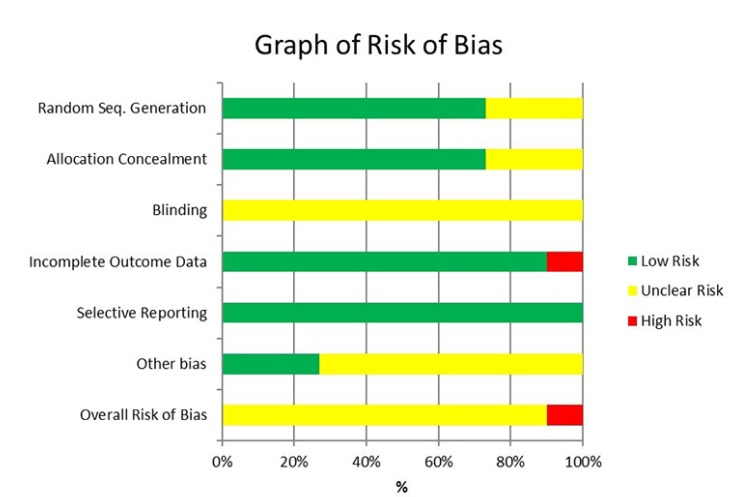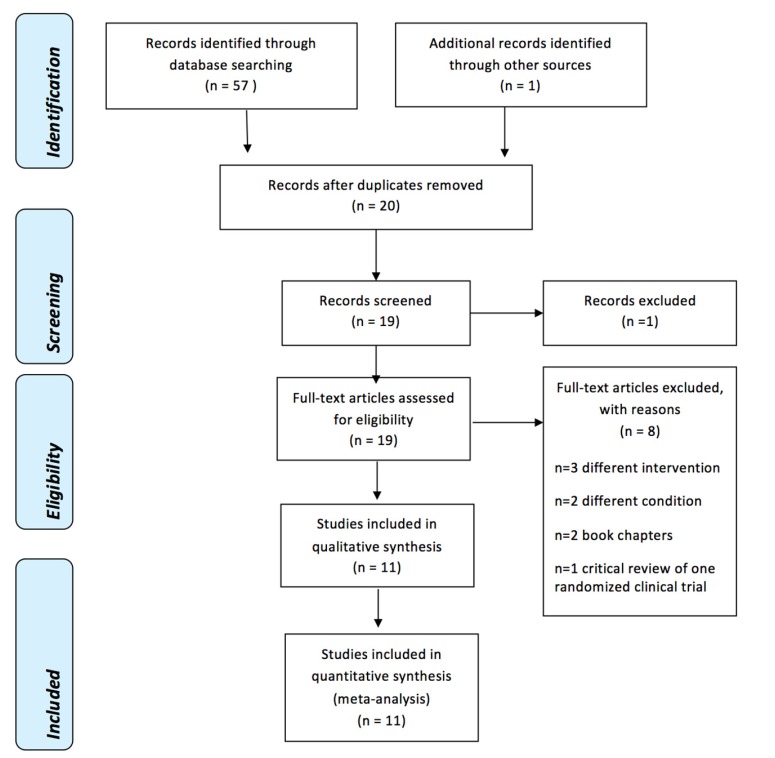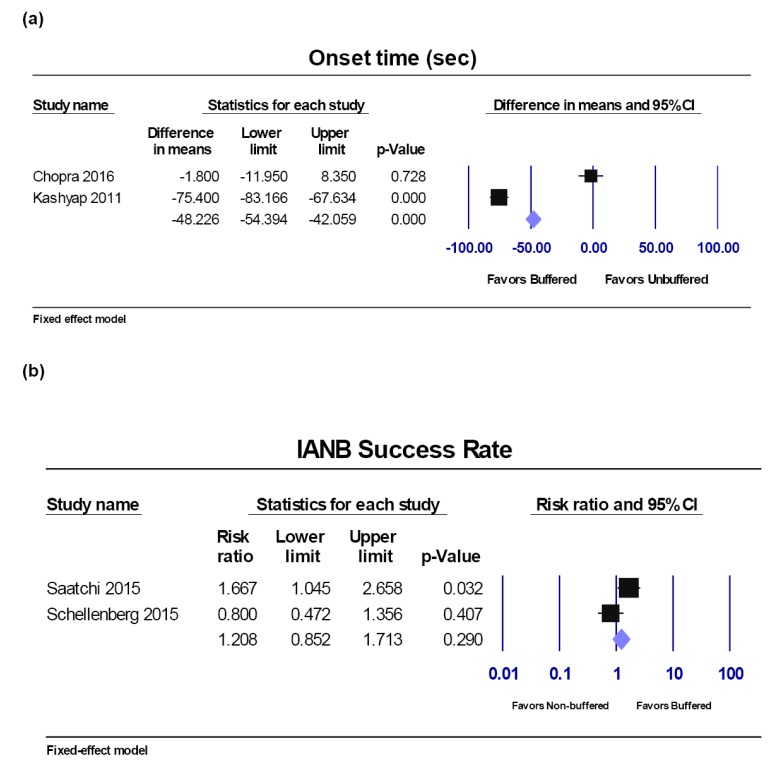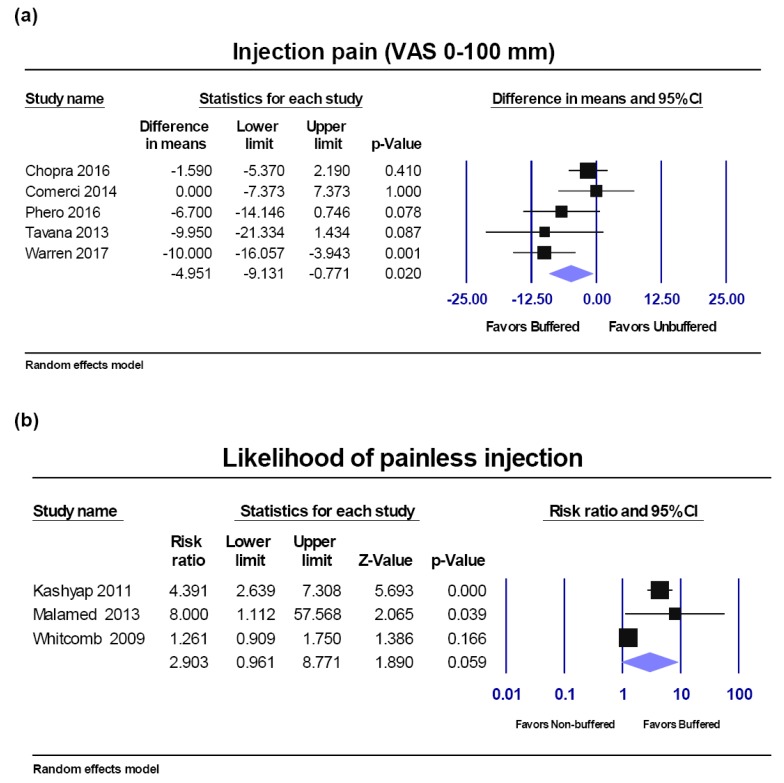J Dent Anesth Pain Med.
2018 Jun;18(3):129-142. 10.17245/jdapm.2018.18.3.129.
Efficacy of sodium bicarbonate buffered versus non-buffered lidocaine with epinephrine in inferior alveolar nerve block: A meta-analysis
- Affiliations
-
- 1Center for Craniofacial Molecular Biology, Herman Ostrow School of Dentistry, University of Southern California, Los Angeles, CA, USA.
- 2Department of Endodontics, School of Dentistry, Loma Linda University, Loma Linda, CA, USA.
- 3Department of Othordontics, Herman Ostrow School of Dentistry, University of Southern California, Los Angeles, CA, USA.
- 4Department of Endodontics, Herman Ostrow School of Dentistry, University of Southern California, Los Angeles, CA, USA.
- 5Dental Public Health & Pediatric Dentistry, Herman Ostrow School of Dentistry, University of Southern California, Los Angeles, CA, USA. renciso@usc.edu
- KMID: 2415177
- DOI: http://doi.org/10.17245/jdapm.2018.18.3.129
Abstract
- INTRODUCTION
This systematic review evaluated the use of buffered versus non-buffered lidocaine to increase the efficacy of inferior alveolar nerve block (IANB).
MATERIALS AND METHODS
Randomized, double-blinded studies from PubMed, Web of Science, Cochrane Library, Embase, and ProQuest were identified. Two of the authors assessed the studies for risk of bias. Outcomes included onset time, injection pain on a visual analog scale (VAS), percentage of painless injections, and anesthetic success rate of IANB.
RESULTS
The search strategy yielded 19 references. Eleven could be included in meta-analyses. Risk of bias was unclear in ten and high in one study. Buffered lidocaine showed 48 seconds faster onset time (95% confidence interval [CI], −42.06 to −54.40; P < 0.001) and 5.0 units lower (on a scale 0-100) VAS injection pain (95% CI, −9.13 to −0.77; P=0.02) than non-buffered. No significant difference was found on percentage of people with painless injection (P = 0.059), nor success rate (P = 0.290).
CONCLUSION
Buffered lidocaine significantly decreased onset time and injection pain (VAS) compared with non-buffered lidocaine in IANB. However due to statistical heterogeneity and low sample size, quality of the evidence was low to moderate, additional studies with larger numbers of participants and low risk of bias are needed to confirm these results.
Keyword
MeSH Terms
Figure
Reference
-
1. Vreeland DL, Reader A, Beck M, Meyers W, Weaver J. An evaluation of volumes and concentrations of lidocaine in human inferior alveolar nerve block. J Endod. 1989; 15:6–12. PMID: 2607268.
Article2. Malamed SF. Handbook of Local Anesthesia-E-Book. 6th edition. Elsevier Health Sciences;2014.3. Frank SG, Lalonde DH. How acidic is the lidocaine we are injecting, and how much bicarbonate should we add? Can J Plast Surg. 2012; 20:71–73. PMID: 23730153.
Article4. Issberner U, Reeh PW, Steen KH. Pain due to tissue acidosis: a mechanism for inflammatory and ischemic myalgia? Neurosci Lett. 1996; 208:191–194. PMID: 8733302.
Article5. Malamed SF, Tavana S, Falkel M. Faster onset and more comfortable injection with alkalinized 2% lidocaine with epinephrine 1:100,000. Compend Contin Educ Dent. 2013; 34(Spec No):10–20. PMID: 23577552.6. Catchlove RF. The influence of CO 2 and pH on local anesthetic action. J Pharmacol Exp Ther. 1972; 181:298–309. PMID: 4537424.7. Davies RJ. Buffering the pain of local anaesthetics: A systematic review. Emerg Med (Fremantle). 2003; 15:81–88. PMID: 12656792.
Article8. Malamed SF. What's new in local anesthesia? Anesth Prog. 1992; 39:125–131. PMID: 1344014.9. Chopra R, Jindal G, Sachdev V, Sandhu M. Double-Blind Crossover Study to Compare Pain Experience During Inferior Alveolar Nerve Block Administration Using Buffered Two Percent Lidocaine in Children. Pediatr Dent. 2016; 38:25–29.10. Comerci AW, Maller SC, Townsend RD, Teepe JD, Vandewalle KS. Effect of a new local anesthetic buffering device on pain reduction during nerve block injections. Gen Dent. 2015; 63:74–78.11. Donaldson TV. Sodium bicarbonate buffered 2% lidocaine 1:100,000 epinephrine versus unbuffered 2% lidocaine 1:100,000 epinephrine for inferior alveolar nerve block injections. The Texas A&M University System Health Science Center, ProQuest Dissertations Publishing;2006.12. Kashyap VM, Desai R, Reddy PB, Menon S. Effect of alkalinisation of lignocaine for intraoral nerve block on pain during injection, and speed of onset of anaesthesia. Br J Oral Maxillofac Surg. 2011; 49:e72–e75. PMID: 21592633.
Article13. Phero JA, Nelson B, Davis B, Dunlop N, Phillips C, Reside G, et al. Buffered Versus Non-Buffered Lidocaine With Epinephrine for Mandibular Nerve Block: Clinical Outcomes. J Oral Maxillofac Surg. 2017; 75:688–693. PMID: 27815105.
Article14. Saatchi M, Khademi A, Baghaei B, Noormohammadi H. Effect of sodium bicarbonate-buffered lidocaine on the success of inferior alveolar nerve block for teeth with symptomatic irreversible pulpitis: a prospective, randomized double-blind study. J Endod. 2015; 41:33–35. PMID: 25442722.
Article15. Schellenberg J, Drum M, Reader A, Nusstein J, Fowler S, Beck M. Effect of Buffered 4% Lidocaine on the Success of the Inferior Alveolar Nerve Block in Patients with Symptomatic Irreversible Pulpitis: A Prospective, Randomized, Double-blind Study. J Endod. 2015; 41:791–796. PMID: 25841959.
Article16. Tavaka SP. Pain experiences in pediatric dental patients to buffered and conventional local anesthesia. University of California, San Francisco ProQuest Dissertations Publishing;2013. 1541898.17. Warren VT, Fisher AG, Rivera EM, Saha PT, Turner B, Reside G, et al. Buffered 1% Lidocaine With Epinephrine Is as Effective as Non- Buffered 2% Lidocaine With Epinephrine for Mandibular Nerve Block. J Oral Maxillofac Surg. 2017; 75:1363–1366. PMID: 28153755.18. Whitcomb M, Drum M, Reader A, Nusstein J, Beck M. A prospective, randomized, double-blind study of the anesthetic efficacy of sodium bicarbonate buffered 2% lidocaine with 1:100,000 epinephrine in inferior alveolar nerve blocks. Anesth Prog. 2010; 57:59–66. PMID: 20553136.
Article19. Shurtz R, Nusstein J, Reader A, Drum M, Fowler S, Beck M. Buffered 4% Articaine as a Primary Buccal Infiltration of the Mandibular First Molar: A Prospective, Randomized, Double-blind Study. J Endod. 2015; 41:1403–1407. PMID: 26095381.20. Ridenour S, Reader A, Beck M, Weaver J. Anesthetic efficacy of a combination of hyaluronidase and lidocaine with epinephrine in inferior alveolar nerve blocks. Anesth Prog. 2001; 48:9–15. PMID: 11495405.21. Brennan PA, Morley MR, Langdon JD. A study of the effectiveness of dental 2% lignocaine local anaesthetic solution at different pH values. Br Dent J. 1987; 163:158–159. PMID: 3478056.
Article22. Syverud SA, Jenkins JM, Schwab RA, Lynch MT, Knoop K, Trott A. A comparative study of the percutaneous versus intraoral technique for mental nerve block. Acad Emerg Med. 1994; 1:509–513. PMID: 7600396.
Article23. Saatchi M, Farhad AR, Shenasa N, Haghighi SK. Effect of Sodium Bicarbonate Buccal Infiltration on the Success of Inferior Alveolar Nerve Block in Mandibular First Molars with Symptomatic Irreversible Pulpitis: A Prospective, Randomized Double-blind Study. J Endod. 2016; 42:1458–1461. PMID: 27507627.24. Higgins JP, Green S. Cochrane handbook for systematic reviews of interventions. The cochrane collaboration;2011.25. Wan X, Wang W, Liu J, Tong T. Estimating the sample mean and standard deviation from the sample size, median, range and/or interquartile range. BMC Med Res Methodol. 2014; 14:135. PMID: 25524443.
Article26. Cochran WG. The combination of estimates from different experiments. Biometrics. 1954; 10:101–129.
Article27. Higgins JP, Thompson SG. Quantifying heterogeneity in a meta-analysis. Stat Med. 2002; 21:1539–1558. PMID: 12111919.
Article28. Lem LC. Efficacy and pain of inferior alveolar nerve block with alkalinized lidocaine. J Oral Maxillofac Surg. 1991; 49:86.
Article29. Reader A, Nusstein J, Drum M. Clinical Factors Related to Local Anesthesia. Successful local anesthesia for restorative dentistry and endodontics. Quintessence Publishing;2017. p. 1–40.30. Reader A, Nusstein J, Drum M. Mandibular Anesthesia. Successful local anesthesia for restorative dentistry and endodontics. Quintessence Publishing;2017. p. 41–91.31. Parirokh M. Buffered Lidocaine With Sodium Bicarbonate did not Increase Inferior Alveolar Nerve Block Success Rate in Patients Having Symptomatic Irreversible Pulpitis. J Evid Based Dent Pract. 2016; 16:59–61.
Article32. Aulestia-Viera PV, Braga MM, Borsatti MA. The effect of adjusting the pH of local anaesthetics in dentistry: a systematic review and meta-analysis. Int Endod J. 2018; 1. 29. DOI: 10.1111/iej.12899.
Article33. Moher D, Liberati A, Tetzlaff J, Altman DG. PRISMA Group. Preferred reporting items for systematic reviews and meta-analyses: the PRISMA statement. PLoS Med. 2009; 6:e1000097. PMID: 19621072.
Article34. O'Connor D, Green S, Higgins J. Defining the review question and developing criteria for including studies. Cochrane handbook for systematic reviews of interventions. 2008. p. 81–94. Cochrane book series.
- Full Text Links
- Actions
-
Cited
- CITED
-
- Close
- Share
- Similar articles
-
- Pain perception and efficacy of local analgesia using 2% lignocaine, buffered lignocaine, and 4% articaine in pediatric dental procedures
- A clinical study of anesthetic efficacy of alkalinizing lidocaine in inferior alveolar nerve blocks
- Anesthetic efficacy of buffered 4% articaine for mandibular first molar infiltration: a crossover clinical trial
- Vascular effects of the inferior alveolar nerve injection of 2% lidocaine hci with 1:100,000 epinephrine
- Updates on the Inferior Alveolar Nerve Block Anesthesia





